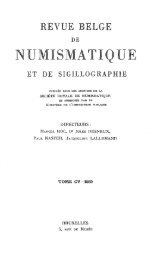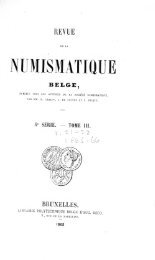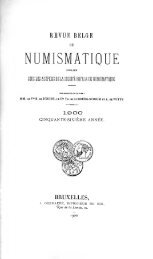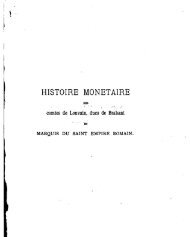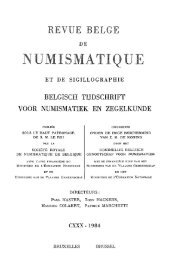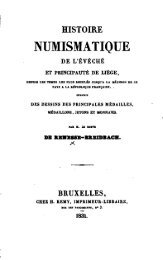PDF Printing 600 dpi - Koninklijk Belgisch Genootschap voor ...
PDF Printing 600 dpi - Koninklijk Belgisch Genootschap voor ...
PDF Printing 600 dpi - Koninklijk Belgisch Genootschap voor ...
You also want an ePaper? Increase the reach of your titles
YUMPU automatically turns print PDFs into web optimized ePapers that Google loves.
NOTES ET DOCUMENTS - NOTA'S EN DOCUMENTEN 219<br />
The main problem however was Ilot to establish whether spirals<br />
were used or not as ornaments on coins but to find out if these spirals<br />
served as a basic constructive element for the calligrapher. This problem<br />
is far more difficult to solve.<br />
A first question that has to be answered concerns the spiral itself.<br />
Is it a geometrically correct constructed spiral or is it a spiral<br />
shaped motive that only serves to fill the blanks in a calligraphie<br />
composition? In the last case the spiral can't he considered as a<br />
constructive element in the artistic composition of the legend since<br />
it is added only after the calligraphy has been completed. For a<br />
series of coins with a fairly visible spiral motive we reconstructed a<br />
geometrically correct spiral and compared it to the spiral actually<br />
depicted on the coin. The result of this small investigation - about<br />
50 coins were stuc1ied -was very encouraging since in all cases studied<br />
the spiral motive followed very closely the geometrical spiral and<br />
if in sorne cases deviations were found these could be explained without<br />
basic difficulties (7).<br />
A next step was to find more proof to support the initial hypothesis.<br />
We tried to discover what was first: the ornamental spiral or the<br />
calligraphied Iegend ? \Ve are quite well aware of the fact that the<br />
Humber of coins we studied is tao small to allow any final conclusion<br />
but sorne details are nevertheless remarkable. The tracé of the<br />
ornamental spiral is compulsory, since it is, as we saw already constructed<br />
in a geometrically correct way. It does not allow any serious<br />
deviation without disrupting the fixed pattern. And if on the other<br />
hand we see that the tracé of the calligraphy closely follows that of<br />
the spiral one is forced to admit that the legend was composed accordingly<br />
the ornamental spiral. One of the most striking examples<br />
of coins on which the tracé of the calligraphy closely Iollows the spiral<br />
pattern is the (ob verse of the) remarkable multiple ashrafi struck at<br />
Isfahan in the year 1135 A.H. (8). In this case hardly any doubt can<br />
subsist. Ii seems obvious that the calligrapher took the spiral as a<br />
starting point from which he started developing the inscription (see<br />
ills.).<br />
We realize that the material studied may Ilot have been representative<br />
for the totality of the Safavid coinage but ''le think that in the<br />
future the following working hypothesis will give a sound stimulus<br />
to the study of the aesthetics of Persian and Indian coinage durîng<br />
the l1th and 12th century A.H.: calligraphers or engravers used<br />
regularly geometrically construcieâ spirals as an aid for composing<br />
(7) On sorne coins the motive, aîter a srnall deviation returns to its « original 0<br />
pattern which proves weil enough that the motive does not just fin up the<br />
empty spaces as a result of sorne supposed horror oacui.<br />
(8) F ARAl-IBAIŒSH, op. cil., p. 46 calls il a 10 asbrafi coin. He fails ta indlcate<br />
that the coin illustrated in his îlgnre 156 is the one of the Cabinet. des Méd~PJes<br />
at Paris.




